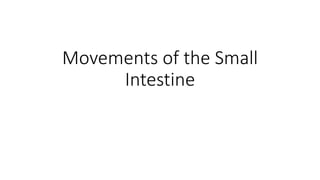
Movements of the small intestine
- 1. Movements of the Small Intestine
- 2. • The movements of the small intestine, like those elsewhere in the gastrointestinal tract, can be divided into 1)mixing contractions and 2)propulsive contractions.
- 3. Mixing Contractions (Segmentation Contractions) • When a portion of the small intestine becomes distended with chyme, stretching of the intestinal wall elicits localized concentric contractions spaced at intervals along the intestine and lasting a fraction of a minute.
- 4. • The segments divide the intestine into spaced segments that have the appearance of a chain of sausages. • As one set of segmentation contractions relaxes, a new set often begins, but the contractions this time occur mainly at new points between the previous contractions. Therefore, the segmentation contractions “chop” the chyme two to three times per minute, in this way promoting progressive mixing of the food with secretions of the small intestine • The maximum frequency of the segmentation contractions in the small intestine is determined by the frequency of electrical slow waves in the intestinal wall, which is the basic electrical rhythm.
- 5. • this frequency normally is not over 12 per minute in the duodenum and proximal jejunum, the maximum frequency of the segmentation contractions in these areas is also about 12 per minute, but this occurs only under extreme conditions of stimulation. • In the terminal ileum, the maximum frequency is usually eight to nine contractions per minute. • The segmentation contractions become exceedingly weak when the excitatory activity of the enteric nervous system is blocked by the drug atropine. Therefore, even though it is the slow waves in the smooth muscle itself that cause the segmentation contractions, these contractions are not effective without background excitation mainly from the myenteric nerve plexus.
- 6. Propulsive Movements Peristalsis in the Small Intestine. Chyme is propelled through the small intestine by peristaltic waves. • These can occur in any part of the small intestine, and they move toward the anus at a velocity of 0.5 to 2.0 cm/ sec, faster in the proximal intestine and slower in the terminal intestine. • They are normally weak and usually die out after traveling only 3 to 5 centimeters, rarely farther than 10 centimeters, so forward movement of the chyme is very slow, so slow that net movement along the smallintestine normally averages only 1 cm/min. • This means that 3 to 5 hours are required for passage of chyme from the pylorus to the ileocecal valve.
- 7. Control of Peristalsis by Nervous and Hormonal Signals • Peristaltic activity of the small intestine is greatly increased after a meal. This is caused partly by the beginning entry of chyme into the duodenum causing stretch of the duodenal wall. • peristaltic activity is increased by the so-called gastroenteric reflex that is initiated by distention of the stomach and conducted principally through the myenteric plexus from the stomach down along the wall of the small intestine.
- 8. • The nervous signals that may affect small intestinal peristalsis, several hormonal factors also affect peristalsis. • They include gastrin, CCK, insulin, motilin, and serotonin, all of which enhance intestinal motility and are secreted during various phases of food processing. • secretin and glucagon inhibit small intestinal motility
- 9. Peristaltic Rush Although peristalsis in the small intestine is normally weak, intense irritation of the intestinal mucosa, as occurs in some severe cases of infectious diarrhea, can cause both powerful and rapid peristalsis, called the peristaltic rush. This is initiated partly by nervous reflexes that involve the autonomic nervous system and brain stem and partly by intrinsic enhancement of the myenteric plexus reflexes within the gut wall itself. The powerful peristaltic contractions travel long distancesin the small intestine within minutes, sweeping the contents of the intestine into the colon and thereby relieving the small intestine of irritative chyme and excessive distention.